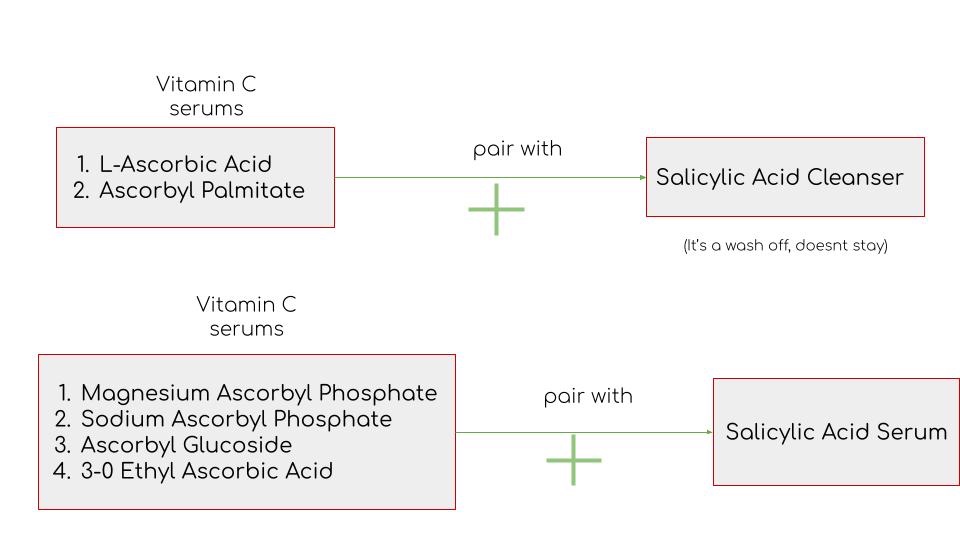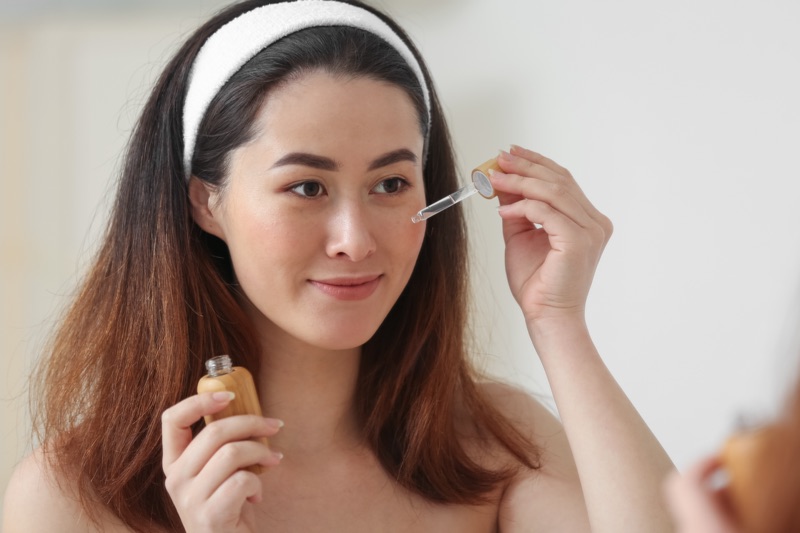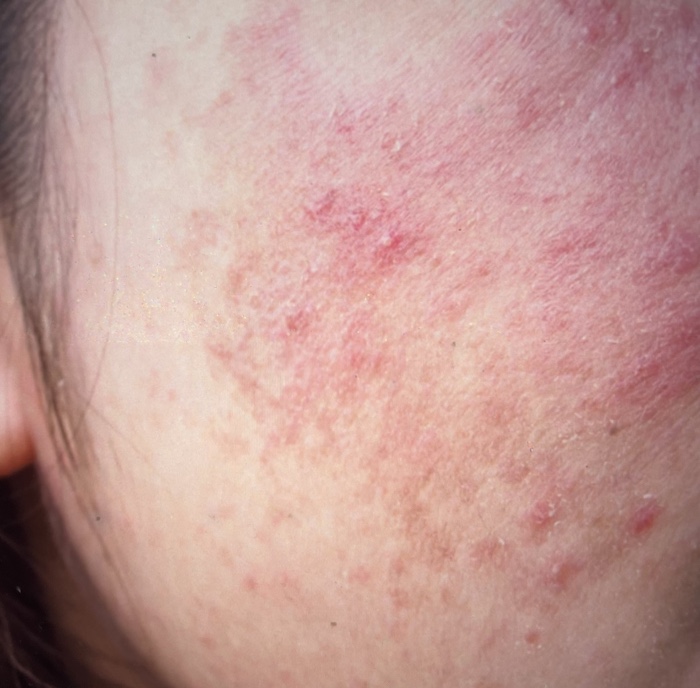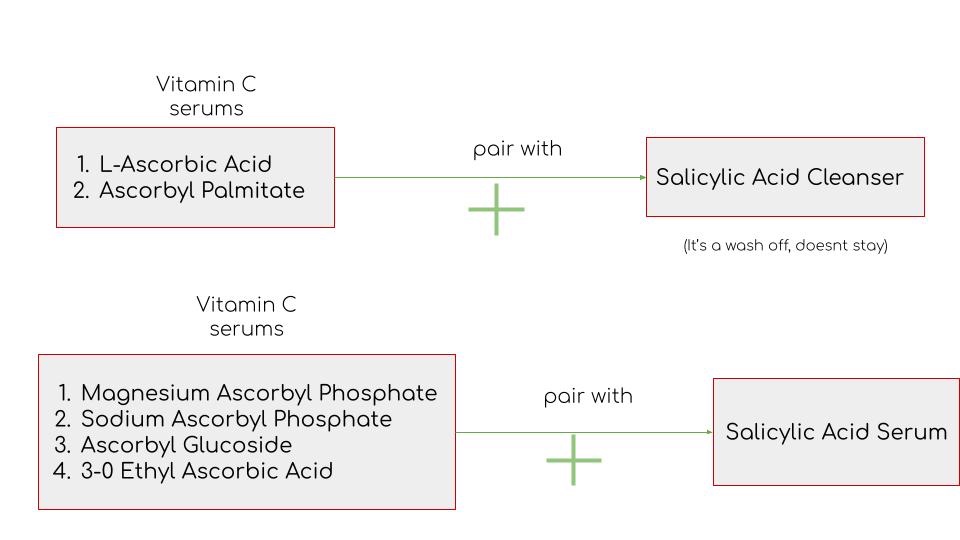We all know both Salicylic acid and Vitamin C are individually great powerful ingredients, but can you use them together? YES, you can, but these two ingredients are a bit tricky to pair together. So do know carefully which kind of Vitamin C pairs, in which form with Salicylic acid to save from irritated peeled skin.
When we are talking about acids on the skin, we can’t afford to be “half-knowledge” guys. If you really want to correctly incorporate these acids without stinging, FOCUS & be ready for the shortest chemistry class. I’ll put it in the easiest way. Promise.
Combining Salicylic Acid and Vitamin C together?
| Salicylic Acid | 4 |
| Form | PH |
|---|---|
| L-Ascorbic Acid | Under 3.5 |
| Magnesium Ascorbyl Phosphate | 7 |
| Sodium Ascorbyl Phosphate | 7 |
| Ascorbyl Glucoside | 5-8 |
| 3-0 Ethyl Ascorbic Acid | 5.5 |
| Ascorbyl Glucoside | Under 3.5 |
| Skin | 4.7 – 5.7 |
Back to, Salicylic acid and Vitamin C.
- Both in the serum form,
If you want to use both Salicylic acid and Vitamin C in the serum form only, mind you it’s going to be strong & overly acidic for the skin, so choose the correct PH of Vitamin C type, with the help of the above-mentioned PH table. Pair Salicylic acid serum with less acidic kinds of vitamin C serum which means a high PH number. So, the ingredients are- MAP, SAP, Ascorbyl Glucoside & 3-0 Ethyl Ascorbic Acid.
But, what about L-ascorbic acid & Ascorbyl palmitate? Can’t they be used with Salicylic acid too?
Well, their PH is under 3.5 which is low & acidic, so if you want to use them with Salicylic acid, use only the cleanser form of Salicylic acid (rather than serum form). Why? Cleansers are wash-offs, they do their work & don’t stay on the skin. Hence, No over-acidity. Also, this is the only way to incorporate L-ascorbic acid & Salicylic acid safely together.
For your Revision & clarity, I have made this diagram,

Why should you use salicylic acid before Vitamin C first in your skincare routine?
Salicylic acid increases the skin’s acidity beforehand making the way for Vitamin C to penetrate better into the skin.
But what about the companies selling both Vitamin C and Salicylic acid together in a bottle as serums?
Well, they have been formulated & stabilized perfectly in the labs, so they don’t cause any irritation to the skin. But when we try to be the chemists in our bathrooms by mixing these active ingredients, it’s either better to know their scientific backgrounds or simply use them separately.
Let’s know Vitamin C and Salicylic Acid personally also,
Vitamin C

All you hear is the term “Vitamin C” all the time in the skincare world & you are buying skincare products blindly which have vitamin C written on them. Do you know, Vitamin C is divided into 6 kinds & a lot of the kinds are not even effective honestly. You keep buying serums that have vitamin C Labeled on it. Please don’t waste your hard-earned money on ineffective things guys.
Let’s clear all the vitamin C confusion today so that you buy the absolute correct & most effective version of vitamin C.
Vitamin C is a topical antioxidant which is also known as the brightening vitamin that’s backed up with decades of clinical testing to prove its solid efficacy in treating free radical damage. It brightens your skin, reduces the appearance of age spots, and unevenly pigmented skin tone & boosts collagen production. Incorporating it daily in your morning skincare routine followed by sunscreen will give you tremendous results.
What does Vitamin C serum do?
- Prevents aging
- Reduces the appearance of uneven skin tone & sun damage
- Builds collagen production
- Adds brightness to the skin by removing dead skin cells & preventing all the oxidative damage from free radicals.
Free radical damage- you keep hearing this a lot I know, what causes free radical damage though? Free radicals are highly reactive molecules generated by some external+internal causes like UV Radiation, Cigarettes, Stress, Air pollutants, Industrial chemicals, Inflammation in the body, high glycemic foods, exhaustive exercises, etc.
Now, the most important factor in deciding which kind of vitamin C to choose for maximum results or your particular skin concerns.
Meet the Vitamin C family
| L-Ascorbic acid | Magnesium Ascorbyl Phosphate | Sodium Ascorbyl Phosphate | Ascorbyl Glucoside | 3-0 Ethyl Ascorbic Acid | Ascorbyl Palmitate | |
|---|---|---|---|---|---|---|
| Description | The most effective & a total gold standard Vitamin C | It can be a support ingredient in your pigment fighting routine but don’t expect anything more. | It can help with tackling acne | Fights off hyperpigmentation & boosts collagen | Helps in Hyperpigmentation | Useless ingredient |
| PH | Under 3.5 | 7 | 7 | 5-8 | 5.5 | Under 3.5 |
| Effective % | 5-20% | 5% | 5% | 2% | 2% | 5-20% |
| Drawback | It is the best. The only drawback could be if it doesn’t suit your skin type. | It does nothing major. It’s only a support pigment fighting ingredient | It’s weakest in collagen boosting production. | Bad antioxidant | Buy it only if you can’t get your hands on any other forms. | Just walk away |
Vitamin C Family
Conclusion
L-Ascorbic acid is in the purest form & the best of all the forms to perform the core vitamin C functions, like brightening, boosting collagen & photo-protecting. Now you know what not to spend money on. Good work. Let’s also see how to boost the effects of Vitamin C even more by pairing it with his favorite pals.
Which ingredients are Vitamin C friendliest with?
- Vitamin E
- Ferulic acid
- Azelaic acid
- Niacinamide
- Hyaluronic acid
- Sunscreen
- Salicylic acid (when paired correctly)
Vitamin C packaging matters a lot!
Vitamin C is an unstable and sensitive ingredient in nature hence it oxidizes easily if it’s susceptible to sunlight, water & oxygen. Regardless of any form you choose, Stability is the most important to give results. Clear yellowish color is the starting fresh point of Vitamin C, when it turns to turn brownish whiskey color, let it go! Always buy serum in a dark packaging bottle & store it away from sunlight & heat, perhaps in your bathroom cabinets.
How to use Vitamin C correctly in your skincare routine?
- Do a patch test first.
- Cleanse your face nicely & pat it dry
- Then start with the lowest concentration if you are using it for the first time.
- Don’t mix it with any other ingredients except the ones I mentioned above.
- Just a few drops are enough to cover the whole face & neck. Massage it in circular form thoroughly.
- Layer it with moisturizer followed by sunscreen
Product Recommendations for Vitamin C
Vitamin C Serums:
- DearKlairs, freshly juiced Vitamin C serum
- Drunk Elephant C Firma fresh day serum
- Paula’s choice C15 Super booster
- SkinCeuticals C E Ferulic
- Timeless skincare 20% Vitamin C+ Ferulic acid+ Vitamin E
- Derma-E Vitamin C renewing moisturizer
- Dr Dennis Gross Vitamin C Lactic Dewy Deep Cream
- Paula’s choice C5 super boost moisturizer
- BIOSSANCE Squalene+ vitamin C rose moisturizer
- Murad Environmental shield Essential C Day Moisture SPF 30 Vitamin C moisturizer
- The Ordinary 100% L-Ascorbic Acid powder
- Good Molecules Vitamin C booster powder
- COSMEDIX- pure vitamin C face powder
This fat-soluble guy is dumped in literally every other product nowadays. It is found over the counter & the reason for its popularity is, it’s a boon for oily/blemish-prone skin.
What does Salicylic acid do for our skin?

- This FDA-approved beta hydroxy acid is oil soluble which is why it is ideal for oily skin & acne prone skin types.
- It dissolves the oil & the dirt that’s clogging the pores, exfoliates the dead skin cells & cleans the skin by going into a deeper layer.
- Salicylic Acid has anti-inflammatory & mild anti-bacterial properties which kill the bacteria which basically chew up on oil & calms the inflammation.
- It is ideal for treating blackheads & whiteheads by dissolving the keratin that clogs the pores causing them.
- It works as a great exfoliating agent by reducing the overall sebum production & keeping the skin oil & bacteria free.
- It comes in different forms- Gels, Masks, Spot treatments, Face cleansers, and Toners.
- It is a much better ingredient to be tolerated by our skin for acne compared to the other potent ingredients because it is milder.
How to use Salicylic acid correctly in your skincare routine?
- Do not mix salicylic acid with some fancy serum you have just discovered online. Salicylic acid doesn’t gel up with most ingredients.
- Always do a patch test before applying it on your face directly for the first time. It may save you from loads of trouble.
- Start with a lower concentration like 0.5%, then gradually when your skin feels ready, you can increase it to 2%.
- Salicylic acid makes the skin sensitive to UV rays so, don’t step out without Sunscreen.
- Avoid using it near your eyes, nose, and mouth. (Extra tip – layer the corners of your eyes, and mouth with Vaseline & then apply salicylic acid).
Which ingredients are salicylic acid compatible with?
- Niacinamide
- Hyaluronic acid
- Vitamin C (when paired correctly)
Who should not use Salicylic acid?
- Don’t use it if you’re pregnant or nursing.
- If you have fresh cuts, scrapes, or rashes on the skin, please don’t use Salicylic acid on those.
- If you have very sensitive skin, do a patch test before directly applying it to the face. Also, start with the lowest concentration.
Does Salicylic Acid have any side effects?
- Dryness
- Peeling skin
- Mild burning sensations
- Increasing skin’s sensitivity towards sun rays
These could be a few side effects; you might have when either using it for the first time or using it incorrectly but mostly it’s not severe.
Products recommendations for Salicylic Acid
Here is the list of the best companies of Salicylic acid products to incorporate into your skincare routine:
- Paula’s Choice- 2% BHA liquid exfoliant
- The Ordinary- Salicylic Acid 2% Solution
- La Roche Posay Effaclar Salicylic acid acne treatment
- Caudalie Vinopure natural Salicylic acid pore minimizing serum
What to do if you get allergic reactions when starting to use Salicylic acid/Vitamin C?

Don’t panic & heal the skin with these tips
- Take cold showers or ice your face (wrapped in a thin cloth). Avoid hot showers at any cost.
- Avoid using scented cleansers or moisturizers.
- Use Thermal spring water to calm the skin (Try from La Roche Posay)
- Don’t use any exfoliating fancy gadgets to wash your face, simply hands.
- Give a lot of moisture & hydration to the skin for it to feel better. Apply moisturizers loaded with ceramides and HA. (Helps in skin barrier)
- Now, seal the skin with a light layer of Vaseline. It locks in all the goodies we’ve given & lets the skin heal faster.
- Stop using any of them or any other exfoliants, acids, AHAs, BHAs, peroxides, or chemical peels until you are completely healed.
- Cica Balms, Glycerin & Aloe vera, are great soothing & calming agents for the skin.
- Product suggestion- Try Avene- Cicalfate + restorative protective cream
- Wear Sunscreen before stepping outside. Remember your skin is already in a vulnerable state. UV rays at this point can make it worse.
Takeaway- Salicylic Acid and Vitamin C together?
YES, Both Salicylic acid and Vitamin C can work together in your skincare routine at the same time. In fact, applying Salicylic acid as the first layer increases the penetration of Vitamin C even more. Just know how to mix them correctly for better results.
When used together, Salicylic acid and Vitamin C works synergistically to improve the overall health of the skin. Salicylic acid clears the dead skin cells and unclogs pores, allowing Vitamin C to absorb better into the skin and improve the damaged and dull skin from within.
Both Salicylic Acid and Vitamin C have anti-aging properties. Salicylic acid can reduce the appearance of fine lines and wrinkles by stimulating Collagen production while Vitamin C fights off all the free radical damage in the skin which helps improve skin’s Elasticity and brightness. Together they work as a powerful anti-aging duo.

If you enjoyed reading this, here are my articles on two other similar pairings: Using Vitamin C with Retinol and Using Salicylic Acid with Retinol.
Love ~ Beauty Stroll
References:
You may also like other articles like:
- Polysorbate 20- Are you using it everyday?
- Azelaic acid and Retinol together – is it a good combination?
- Can you use Glycolic Acid and Retinol?